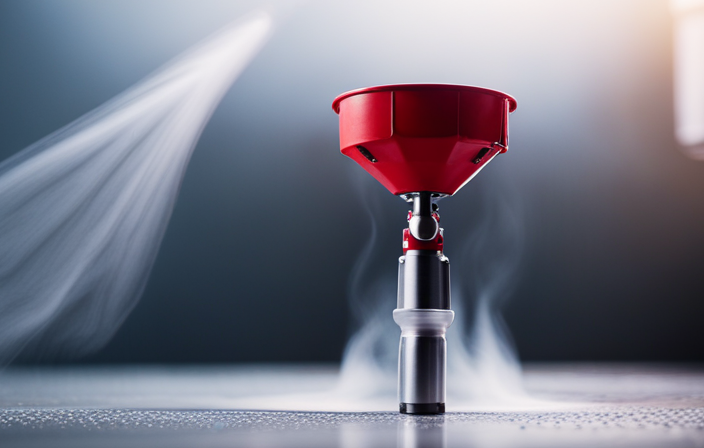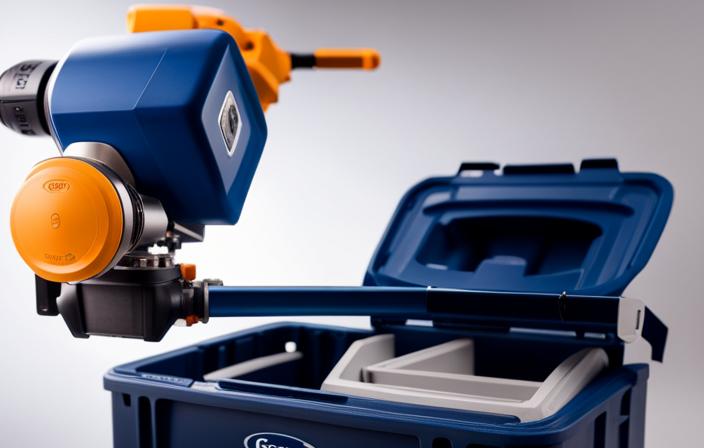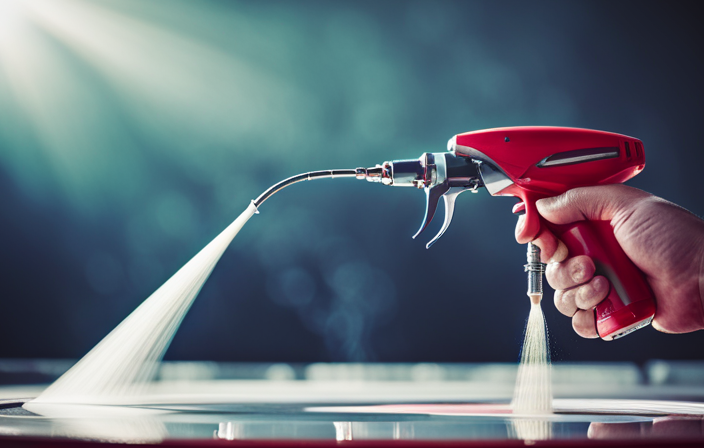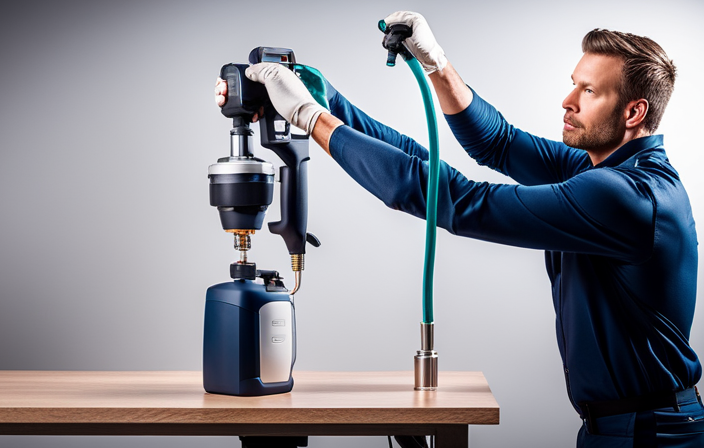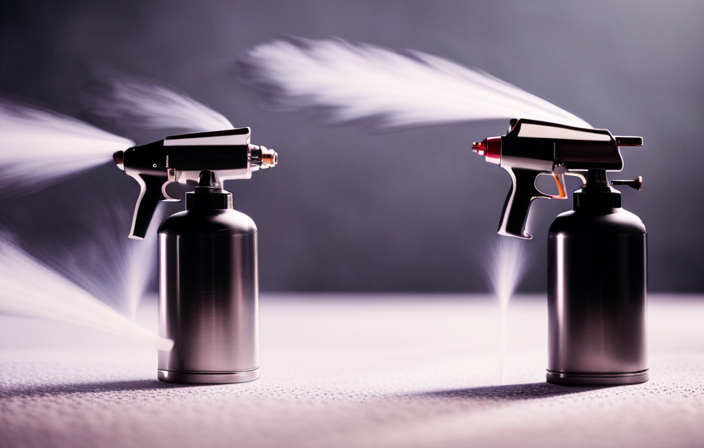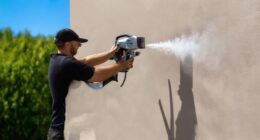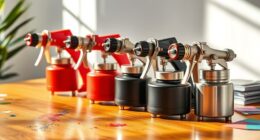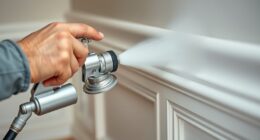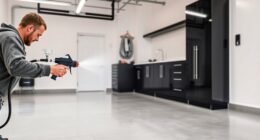As a seasoned painter, I have come to realize the significance of choosing the right filter for an airless paint sprayer. This is essential in achieving a flawless end result. Picture this scenario: you are in the midst of a significant project, adding a fresh coat of paint, when suddenly you notice tiny lumps and particles ruining the smooth finish. Frustrating, right?
That’s where the importance of using a strainer comes in. A strainer acts as a sieve, filtering out any unwanted debris or impurities from your paint, ensuring a consistent and even application. But with so many different types of strainers available, how do you choose the right one?
In this article, I’ll guide you through the world of paint sprayer strainers. We’ll explore the different types, discuss key considerations for choosing the right strainer, and delve into the benefits of using one. I’ll also share proper usage and maintenance tips, along with common mistakes to avoid.
So, let’s get started and ensure your paint job is nothing short of perfection!
Key Takeaways
- Different types of strainers are available for airless paint sprayers, including mesh strainers, bag filters, and cone filters.
- Mesh strainers come in various sizes and materials, with nylon mesh for water-based paints and stainless steel for solvent-based paints.
- Choosing the right strainer involves considering factors such as mesh size, material compatibility, and type of paint being used.
- Regular cleaning and maintenance of the strainer are essential for optimal equipment performance and preventing clogs.
Importance of Using a Strainer in an Airless Paint Sprayer
You’ll want to make sure you use a strainer in your airless paint sprayer, as it plays a crucial role in ensuring a smooth and even spray, preventing clogs, and providing a professional finish to your paint job.
When choosing a strainer for your airless paint sprayer, it’s important to consider the mesh size. A finer mesh will remove smaller particles, ensuring a higher quality spray and reducing the chances of clogs.
Additionally, by straining your paint, you can remove any impurities or debris that may be present, resulting in a smoother finish. The benefits of straining your paint are numerous – it helps improve the flow and consistency of the paint, reduces the risk of blockages in the spray tip, and ensures a more even distribution of pigments.
Now, let’s explore the different types of strainers available for airless paint sprayers.
Different Types of Strainers
When it comes to using a strainer in an airless paint sprayer, there are different types available to choose from. One option is a mesh strainer, which is designed to catch larger particles and debris before they enter the sprayer.
Another type is a bag filter, which offers a larger surface area for filtration and can capture finer particles.
Lastly, there are cone filters, which are ideal for straining thick or heavy materials.
Each type of strainer serves a specific purpose and can greatly improve the performance and longevity of your airless paint sprayer.
Mesh Strainers
Mesh strainers, with their fine screens, effectively filter paint particles, ensuring a smooth and even spray pattern. These strainers come in different sizes to accommodate various paint sprayers and can be made from different materials, such as nylon or stainless steel. The size of the mesh determines the level of filtration, with smaller mesh sizes providing finer filtration.
Nylon mesh strainers are commonly used for water-based paints, while stainless steel mesh strainers are preferred for solvent-based paints. When using a mesh strainer, it’s important to ensure that it’s properly secured to the paint sprayer to prevent any particles from bypassing the strainer.
Bag filters, which we will discuss next, offer another option for paint filtration, providing a more comprehensive filtration solution.
Bag Filters
Bag filters are like the knights in shining armor for your paint application, ensuring that no impurities sneak into your masterpiece. These handy filters provide several benefits that make them a popular choice among professionals and DIY enthusiasts alike. Here are some reasons why you should consider using bag filters in your airless paint sprayer:
-
Easy to use: Bag filters are simple to install and remove, saving you time and effort.
-
Efficient filtration: They effectively trap debris, preventing clogs and ensuring a smooth paint flow.
-
Versatile: Bag filters are compatible with a wide range of paints and coatings, making them suitable for various projects.
-
Cost-effective: Reusable bag filters are a cost-efficient option as they can be cleaned and reused multiple times.
-
Low maintenance: With proper care and cleaning, bag filters can last for a long time, saving you money in the long run.
Now, let’s transition to the next section about cone filters, which offer another option for your airless paint sprayer.
Cone Filters
Get ready to experience a whole new level of filtration with cone filters – they’ll revolutionize the way you achieve that flawless finish in your projects.
Cone filters offer several benefits that make them an excellent choice for your airless paint sprayer. First, their unique shape allows for a more efficient filtration process, ensuring that no impurities or debris make their way into your paint. Additionally, cone filters have a larger surface area compared to other types of filters, allowing for improved paint flow and reducing the risk of clogging.
Maintenance of cone filters is also a breeze. They can be easily cleaned by rinsing with water or solvent, and their durable construction ensures that they can withstand repeated use. Regularly inspecting and replacing cone filters when necessary will help maintain their optimal performance.
Considerations for choosing the right strainer include the mesh size, material compatibility, and the type of paint being used. These factors will ensure that you find the perfect cone filter that meets your specific needs and helps you achieve professional-grade results.
Considerations for Choosing the Right Strainer
When selecting the perfect strainer for your airless paint sprayer, be mindful of the myriad of materials that can be masterfully managed. One important consideration is choosing the right strainer size. The size of the strainer mesh will determine the level of filtration and determine the size of particles that can pass through. It is essential to choose a strainer size that is appropriate for the type of paint or coating you’re using.
Another consideration is the material of the strainer. There are various strainer material options available, including stainless steel, nylon, or paper. Each material has its advantages and drawbacks, so it’s important to choose based on the specific requirements of your project.
By carefully considering the strainer size and material, you can ensure optimal performance and achieve the desired results when using an airless paint sprayer.
Now let’s move on to discussing the benefits of using a strainer.
Benefits of Using a Strainer
When it comes to using a strainer in your airless paint sprayer, there are several benefits that can greatly enhance your painting experience.
First and foremost, using a strainer can help extend the life of your equipment by preventing any debris or impurities from clogging the spray gun.
Additionally, a strainer promotes improved paint flow and performance, ensuring a smooth and even application every time.
Lastly, using a strainer helps guarantee consistent and professional results, as it removes any potential clumps or particles that could affect the final finish.
Extending the Life of Your Equipment
By properly maintaining and caring for your equipment, you can significantly increase its lifespan, ensuring that your investment in an airless paint sprayer pays off for years to come. Extending the equipment’s lifespan requires implementing proper maintenance techniques.
One crucial aspect of maintenance is regularly cleaning and replacing the strainer. The strainer plays a vital role in preventing debris, dirt, and other contaminants from entering the paint sprayer system. Over time, these particles can cause clogs, leading to reduced performance and potential damage to the equipment.
By regularly inspecting and cleaning the strainer, you can ensure a smooth and consistent paint flow, preventing any potential issues. This not only extends the life of your equipment but also improves paint flow and performance, providing you with optimal results.
Improving Paint Flow and Performance
To optimize the performance of your equipment and ensure a smooth and consistent flow of paint, it’s essential to keep your system clean and free from any obstructions. This is similar to how a river flows effortlessly when its path is clear. Here are some tips to improve paint viscosity and prevent clogs:
- Regularly clean and inspect the filters to remove any debris or build-up.
- Use a strainer with a fine mesh size to catch any particles that may affect the paint flow.
- Consider using additives or thinners to adjust the viscosity of the paint for better spraying results.
- Flush the system with a cleaning solution after each use to remove any residual paint or contaminants.
- Properly store your equipment in a clean and dry environment to prevent the accumulation of dust or dirt.
By implementing these practices, you can ensure consistent and professional results in your painting projects.
Ensuring Consistent and Professional Results
Achieving consistent and professional results in your painting projects is all about ensuring a smooth and uninterrupted flow of paint, which can be accomplished by implementing these effective practices.
One important step to achieve this is using a strainer in your airless paint sprayer. Using a strainer has several benefits that contribute to a better painting experience. Firstly, it helps remove any impurities or debris from the paint, ensuring a clean and smooth finish. Additionally, a strainer helps prevent clogs and blockages in the paint sprayer nozzle, which can lead to uneven application and wasted paint.
To ensure the best results, it is important to use the proper strainer for your paint type and to maintain it regularly. This includes cleaning the strainer after each use, replacing it when necessary, and storing it properly. By incorporating these practices, you can achieve consistent and professional results in your painting projects.
Moving on to proper strainer usage and maintenance, it is essential to ensure the longevity and effectiveness of the strainer.
Proper Strainer Usage and Maintenance
Make sure you take good care of your strainer so that it remains effective in sifting out any unwanted debris, like a diligent gatekeeper keeping your paint sprayer clean and clog-free. Here are three best practices for proper strainer maintenance and usage:
-
Clean after each use: After painting, remove the strainer and clean it thoroughly with warm water and a mild detergent. Make sure to remove any dried paint or residue that may have accumulated.
-
Inspect for damage: Regularly inspect your strainer for any signs of wear or damage. If you notice any tears or holes, replace the strainer immediately to prevent debris from entering your paint sprayer.
-
Store properly: When not in use, store your strainer in a clean and dry place to avoid contamination. Avoid placing heavy objects on top of it to prevent deformation.
By following these best practices, you can ensure that your strainer remains in optimal condition, allowing for consistent and professional results.
Now, let’s move on to recommended strainers for airless paint sprayers.
Recommended Strainers for Airless Paint Sprayers
Now that we understand the importance of proper strainer usage and maintenance, let’s discuss the recommended strainers for airless paint sprayers. Using the right strainer can greatly enhance the performance and efficiency of your paint sprayer.
One of the main benefits of strainer maintenance is that it helps prevent clogs and blockages, ensuring a consistent flow of paint and a smooth finish. To keep your strainer in optimal condition, regular cleaning is essential. You can use a brush or a solvent to remove any dried paint or debris from the mesh. Additionally, soaking the strainer in a cleaning solution can help dissolve stubborn paint particles.
By properly maintaining and cleaning your strainer, you can ensure that it continues to provide effective filtration and prevent any paint-related issues.
Now, let’s move on to some tips and tricks for straining paint.
Tips and Tricks for Straining Paint
To ensure a flawless finish, it’s crucial to employ a few handy techniques when straining your paint. Here are some tips and tricks to help you achieve the best results:
-
Use a fine mesh strainer: This’ll remove any impurities or clumps from the paint, ensuring a smooth application.
-
Strain into a clean container: Make sure your straining container’s clean and free from any residue or debris that could contaminate the paint.
-
Stir the paint before straining: This’ll help mix any settled pigments, ensuring an even consistency throughout.
-
Strain in small batches: By straining smaller amounts of paint at a time, you can maintain control and ensure thorough straining.
By incorporating these techniques, you can extend the durability of your paint and maximize its coverage. Now, let’s move on to common mistakes to avoid when using a strainer.
Common Mistakes to Avoid when Using a Strainer
When it comes to using a strainer, there are a few common mistakes that can easily be avoided. One of the biggest mistakes is using the wrong size or type of strainer for the job. It’s important to choose a strainer that’s compatible with your paint sprayer to ensure proper filtration.
Additionally, failing to clean and maintain the strainer regularly can lead to clogs and reduced performance. Lastly, neglecting to strain paint before spraying can result in unwanted debris and particles getting onto your painted surface.
By being mindful of these common mistakes, you can ensure a smooth and successful painting experience.
Using the Wrong Size or Type of Strainer
Don’t make the mistake of using a strainer that’s too small or the wrong type; it’s like trying to fit a square peg into a round hole and it’ll only lead to frustration and disappointment.
When it comes to airless paint sprayers, using the right size and type of strainer is crucial for optimal performance. Here are a few reasons why:
- Proper strainer maintenance is essential to ensure the longevity of your equipment.
- Using a fine mesh strainer helps remove any debris or impurities from the paint, resulting in a smoother finish.
- A well-fitted strainer prevents clogging and blockages, saving you time and effort during your painting project.
- The right strainer allows the paint to flow evenly, preventing uneven coverage or streaks.
By understanding the importance of using the correct strainer, you can avoid unnecessary problems and achieve professional-looking results. However, failing to clean and maintain the strainer can also lead to issues.
[Transition sentence into the subsequent section about ‘failing to clean and maintain the strainer’.]Failing to Clean and Maintain the Strainer
Neglecting proper maintenance and cleaning of your strainer can quickly turn your painting project into a frustrating and messy ordeal. To ensure optimal performance of your airless paint sprayer, it’s essential to regularly clean and maintain the strainer.
Cleaning the strainer is a straightforward process that can be done by removing it from the sprayer and rinsing it with warm soapy water. It’s important to remove any paint residue or debris that may have accumulated on the strainer. Additionally, it’s advisable to clean the sprayer’s filter and nozzle as well.
Regular maintenance of the strainer will not only extend the lifespan of your sprayer but also ensure a smooth and even paint application. By taking the time to clean and maintain your strainer, you’ll avoid clogging issues and achieve professional-looking results.
Now, let’s move on to the next section about the importance of straining paint before spraying.
Neglecting to Strain Paint before Spraying
Make sure you strain your paint before spraying to avoid frustrating and messy results. The importance of straining paint before spraying can’t be overstated. When paint isn’t strained, it can contain impurities like dried clumps or debris that can clog the nozzle of your airless paint sprayer, resulting in uneven spray patterns or even complete blockage. Using a strainer in your airless paint sprayer helps remove these impurities, ensuring a smooth and consistent spray.
Additionally, straining paint helps eliminate any lumps or bits that may be present, resulting in a more professional finish. By taking the extra step to strain your paint, you can save yourself time and frustration by preventing potential issues with your airless paint sprayer.
Moving on to troubleshooting common strainer issues, let’s address some common problems you may encounter.
Troubleshooting Common Strainer Issues
One common issue that can arise with using a strainer in an airless paint sprayer is that it might not filter out all the particles as effectively as expected. This can lead to clogging and uneven spray patterns, resulting in a frustrating painting experience.
To troubleshoot strainer issues and optimize paint flow with a strainer, consider the following:
-
Ensure the strainer is the appropriate mesh size for your paint. Using a finer mesh for thicker paints and a coarser mesh for thinner paints can improve filtration efficiency.
-
Clean the strainer regularly to prevent buildup of paint particles. A clogged strainer can restrict paint flow and cause spraying problems.
-
Check if the strainer is properly installed and secured in the sprayer. Loose or incorrectly positioned strainers can allow particles to bypass the filtering process.
-
If the strainer continues to cause issues, consider upgrading to a higher-quality strainer or using additional filtration methods, such as disposable filters.
By addressing these troubleshooting steps, you can enhance the performance of your paint sprayer and achieve better results.
In the next section, we’ll delve into final thoughts and recommendations for using a strainer in an airless paint sprayer.
Final Thoughts and Recommendations
To wrap up our discussion on troubleshooting common strainer issues in airless paint sprayers, let’s talk about some final thoughts and recommendations.
By addressing these issues, we can greatly improve the efficiency of our sprayers and minimize clogs. When it comes to choosing the right strainer for your airless paint sprayer, it’s important to consider the type and size of particles you’re dealing with.
Fine mesh strainers are ideal for preventing small debris from clogging the spray tip, while larger mesh strainers are better suited for thicker materials. Additionally, regularly cleaning and inspecting the strainer for any buildup or damage is crucial for optimal performance.
Investing in high-quality strainers and replacing them when necessary will ultimately save you time and money in the long run. Remember, a properly functioning strainer is key to achieving a flawless paint finish.
Frequently Asked Questions
Can I use any type of strainer in an airless paint sprayer?
Yes, you can use different types of strainers in an airless paint sprayer. However, it is important to choose the appropriate strainer based on the paint type and its viscosity to ensure smooth and efficient operation.
How often should I clean or replace the strainer in my airless paint sprayer?
I should clean or replace the strainer in my airless paint sprayer after every use to ensure optimal performance. If a strainer is not available, alternative methods such as using a mesh screen or cheesecloth can be used for straining paint.
Is it necessary to strain paint before using it in an airless paint sprayer?
Before using an airless paint sprayer, it is necessary to strain the paint. Straining removes debris, ensuring a smooth and even application. Failing to strain can lead to clogging, uneven coverage, and costly equipment damage.
Can I use a strainer for other types of paint applications besides airless sprayers?
Yes, a strainer can be used for other types of paint applications besides airless sprayers. It helps remove impurities and ensure a smooth finish. There are also alternative options available for straining paint, such as disposable filters or mesh screens.
What are some alternative methods to straining paint if I don’t have a strainer available?
When it comes to straining paint without a strainer, there are a few alternative methods you can try. One option is to use a fine mesh sieve or cheesecloth to remove any impurities. Another method is to pour the paint through a funnel lined with a coffee filter. Both of these methods can help ensure a smooth and even application of paint.
Conclusion
As I conclude, I must emphasize the significance of using a strainer in an airless paint sprayer. Like a harmonious melody that flows effortlessly, the strainer ensures a smooth and flawless painting experience.
With its various types and considerations for selection, it symbolizes the attention to detail and precision required in the art of painting. The benefits of using a strainer are undeniable, from preventing clogs to achieving a professional finish.
By properly using and maintaining the strainer, one can master the art of straining paint and avoid common mistakes. Remember, troubleshooting any strainer issues is crucial for a successful painting journey.
In my knowledgeable and precise style, I recommend embracing the power of the strainer in your airless paint sprayer for unparalleled results.
